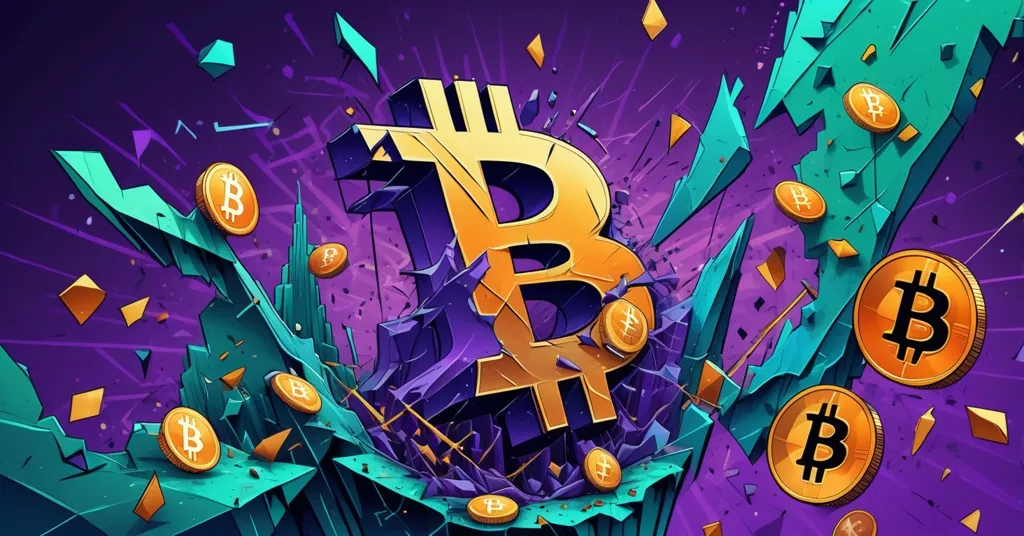Altcoins XRP, Solana, Pepe Rise as Bitcoin Crashes to $83K—Next Bull Run Leaders?

Best Crypto to Buy Now: Can XRP, Solana, and Pepe Outshine Bitcoin’s Stumble?
Bitcoin’s brutal retreat from a jaw-dropping $126,080 on October 6 to a six-month low of $83,814 has rattled the crypto market, leaving investors scrambling for the next big thing. As whispers of a cyclical reset swirl, the spotlight is shifting to altcoins like XRP, Solana (SOL), and Pepe (PEPE), alongside a wildcard in Bitcoin Hyper (HYPER). Are these contenders poised to lead the charge, or just shiny distractions in a volatile landscape?
- Bitcoin’s Crash: From a high of $126,080 to $83,814, signaling a market reset.
- Altcoin Surge: XRP, Solana, and Pepe gain traction as potential bull run leaders.
- Newcomer Hype: Bitcoin Hyper, a layer-2 project, raises $28.25M in presale buzz.
Bitcoin’s Fall: A Necessary Purge or Warning Sign?
Let’s cut to the chase—Bitcoin’s nosedive stings. After scaling a record peak just weeks ago, BTC’s tumble to $83,814 feels like a betrayal for those who bought into the hype. Yet, some market watchers aren’t panicking. They see this as a classic cycle, a brutal but needed flush of leveraged positions and speculative froth that often precedes a healthier rally. Think of it as the market taking out the trash—overextended traders get burned, leaving room for more grounded growth. But what triggered this drop? Macro pressures like rising interest rates, potential whale sell-offs (large holders dumping coins), and lingering regulatory fears could be at play. Bitcoin’s dominance, sitting at roughly 50% of the total crypto market cap—the total value of all circulating coins—still looms large, but cracks are showing.
Here’s the devil’s advocate take: is Bitcoin’s first-mover advantage and store-of-value narrative still unassailable, or are we witnessing the slow bleed of its relevance? As the original blockchain and a beacon of decentralization, Bitcoin embodies the ethos of financial freedom and privacy we champion. Yet, its scalability issues and lack of native smart contract support—self-executing code enabling complex apps—leave gaps that altcoins are eager to fill. While BTC remains the bedrock of crypto, this dip might signal an “altcoin season,” a historical pattern where alternative coins outperform Bitcoin after its corrections, as seen in cycles like 2017 and 2021. Whether this is a temporary blip or a deeper shift, the door’s open for others to steal the show.
XRP: Fintech Disruptor or Regulatory Punching Bag?
XRP, tied to Ripple’s payment protocol, isn’t just another token—it’s a direct challenge to centralized banking giants. With a market cap north of $116 billion, making it the fourth-largest cryptocurrency, XRP aims to replace clunky, expensive systems like SWIFT, the traditional network for international bank transfers notorious for delays and high fees. Ripple’s tech, using XRP, enables near-instant cross-border payments at a fraction of the cost, positioning it as a fintech heavyweight. Its price tells a story of resilience: a 70% surge over the past year, peaking at a six-year high of $3.65 in July, now trading at $1.94. A technical indicator called Relative Strength Index (RSI), which measures if a coin is overbought or oversold, sits at 31 for XRP—below 30 often hints at undervaluation, suggesting room for a bounce.
What’s fueling the optimism? Nine XRP exchange-traded funds (ETFs) launched this week, offering traditional investors a regulated way to gain exposure without holding the token directly. Reports linking XRP to discussions with entities like the UN Capital Development Fund and even White House mentions add credibility to its role in digital finance. If regulatory tailwinds materialize—think clearer U.S. policies via frameworks like Project Crypto—XRP could soar. But let’s not sip the Kool-Aid just yet. The elephant in the room is Ripple’s ongoing legal brawl with the SEC, dating back to 2020, over whether XRP is an unregistered security. A “security” label could mean delistings from exchanges, hefty fines, or stifled adoption, a guillotine hanging over its price. Partnerships with banks and stablecoin initiatives like RLUSD are promising, but timelines for mainstream use are murky at best. XRP embodies the fight against financial gatekeepers, yet its fate hinges on bureaucrats in suits—ironic for a decentralization advocate, isn’t it?
Solana: Speed Demon with a Shaky Track Record
Solana (SOL) is the blockchain darling for those betting on speed and scalability over Ethereum’s slower, costlier network. With a market cap exceeding $71 billion and $9 billion in total value locked (TVL) in its decentralized finance (DeFi) ecosystem—financial apps on blockchain cutting out middlemen like banks—Solana processes thousands of transactions per second at pennies per trade. Compare that to Ethereum’s current pace of 15-30 transactions per second with fees often hitting double digits, and you see why developers flock to it. SOL trades at $128, up from a yearly low of $100, with its all-time high of $293.31 in sight. Institutional moves amplify the buzz: spot ETFs from Grayscale and Bitwise on the NYSE, plus adoption by giants like Franklin Templeton and BlackRock for tokenizing real-world assets—think digitizing property or art on-chain—signal serious mainstream potential.
But Solana’s not the flawless Ethereum-killer it’s hyped to be. Its history of network outages, including a major 17-hour downtime in September 2021 and sporadic hiccups since, has dented trust. Each glitch sends users and developers questioning if speed sacrifices stability—especially when Ethereum, for all its flaws, boasts near-perfect uptime. Recent fixes like the Firedancer validator client aim to bolster reliability, but the jury’s still out. And while Solana’s DeFi TVL is impressive, Ethereum’s $50 billion-plus dwarfs it, reflecting a deeper developer and user base. From a Bitcoin maximalist lens, Solana’s focus on throughput over decentralization raises eyebrows—does it undermine blockchain’s core promise of security and censorship resistance, the very principles Bitcoin upholds? Still, Solana’s push for DeFi and asset tokenization aligns with disrupting traditional finance, a mission we can’t ignore. It’s a contender, but far from a crowned champion.
Pepe: Meme Coin Madness or Market Mockery?
Pepe (PEPE), inspired by Matt Furie’s internet-famous frog, is the kind of crypto project that makes purists cringe. Launched in April 2023, this meme coin boasts a $1.7 billion market cap despite having no real utility beyond community hype and cultural resonance. Trading at a measly $0.000004255, down 85% from its 2024 peak of $0.00002803, it’s the poster child for speculative mania. An RSI of 31 suggests it’s oversold, potentially attracting bargain hunters—or “degens,” slang for reckless traders chasing moonshots. A fleeting moment when Elon Musk swapped his X profile photo to a Pepe meme sparked rumors of his involvement, though nothing’s confirmed. If U.S. regulatory reforms ease crypto restrictions, or if market sentiment flips, Pepe could ride a wave of FOMO (fear of missing out) to new highs. For deeper insights into trending coins like Pepe, check out this analysis on top cryptos to buy now including XRP and Solana.
Let’s be brutally honest: Pepe’s a circus act in a market desperate for clowns—entertaining until the tent collapses. Meme coins thrive on Twitter buzz and collective delusion, not fundamentals. History’s littered with scams like the Squid Game token, which rug-pulled investors for millions in 2021 when devs vanished with funds. Pepe’s no stranger to such risks; a lack of transparency and reliance on viral momentum could tank it overnight. From our decentralization advocacy standpoint, Pepe’s chaotic rebellion against financial norms has a perverse charm, but does it mock the industry’s credibility? When Bitcoin was born to fight centralized control, are frog memes diluting the message? This is a gamble for the insane or the ironic—don’t say we didn’t warn you.
Bitcoin Hyper: Layer-2 Dream or Presale Trap?
Bitcoin Hyper (HYPER) enters the scene as a curious blend of meme branding and tech ambition. Billed as a Bitcoin layer-2 solution built on the Solana Virtual Machine, it aims to turbocharge BTC’s sluggish transactions and add smart contract support—code that automates agreements, something Bitcoin lacks natively. Layer-2s are secondary networks atop a blockchain to enhance speed and functionality; think Lightning Network, Bitcoin’s payment-focused layer-2 with mixed adoption success. HYPER’s presale raised over $28.25 million, dangling early staking yields of 41% APY (annual return for locking tokens) and analyst predictions of 100x gains from voices like Borch Crypto. An audit by Coinsult found no smart contract vulnerabilities, adding a veneer of legitimacy.
Hold the applause. A 41% APY in crypto is like spotting a unicorn at a petting zoo—magical until you realize it’s probably fake. Presale projects are notorious for overpromising and underdelivering; the graveyard of failed tokens from 2017’s ICO craze to today’s hype cycles proves it. Bitcoin Hyper’s Solana compatibility could address Bitcoin’s limitations, but layer-2s often struggle with adoption—Lightning Network, despite years of development, handles a fraction of BTC transactions. Who’s behind HYPER? What’s the roadmap post-launch? Without transparency, this smells like a speculative trap. As Bitcoin maximalists, we applaud efforts to scale BTC while preserving its security, but let’s not kid ourselves—unproven projects often exploit Bitcoin’s name for clout. Approach with extreme caution; this could be a diamond or just fool’s gold.
Market Context: Altcoin Season or Speculative Bubble?
Zooming out, Bitcoin’s stumble fits a familiar pattern. Post-peak corrections in 2017 and 2021 saw altcoins surge as capital rotated from BTC into smaller, riskier bets—an “altcoin season” driven by investors chasing outsized returns. XRP, Solana, and Pepe each tap into distinct narratives: fintech disruption, DeFi innovation, and meme mania. Bitcoin Hyper plays on scaling Bitcoin itself, a nod to its enduring centrality. Historically, these cycles peak with euphoria before crashing under the weight of unsustainable hype. Are we on the cusp of genuine altcoin leadership, or just inflating another bubble? Bitcoin’s market sentiment often dictates the broader tide—when BTC bleeds, alts can briefly shine, but they rarely sustain without it. Regulatory shifts, macroeconomics like interest rates, and black-swan events (hacks, bans) could flip the script overnight.
Our stance remains clear: Bitcoin is crypto’s North Star, the ultimate hedge against centralized overreach with unmatched security and ethos. Altcoins bring innovation—XRP’s war on banking inefficiencies, Solana’s DeFi frontier—but often at the cost of decentralization or stability. Meme coins like Pepe and hyped presales like HYPER test our patience for scams and distractions. Effective accelerationism, the push to speed up tech adoption, drives us to cheer blockchain’s disruption of the status quo, but not at the expense of integrity. The next bull run, if it comes, demands critical thinking over blind FOMO. Crypto’s a high-risk game; fortunes vanish faster than a meme coin’s relevance. Bet smart, not reckless.
Key Takeaways and Questions Answered
- What’s driving Bitcoin’s drop to $83,814?
A mix of market cycle dynamics, clearing speculative leverage, plus macro factors like interest rates and regulatory fears, likely fueled the crash from $126,080. It could be a reset for future growth—or a bearish warning. - Why are altcoins like XRP, Solana, and Pepe in focus?
With Bitcoin faltering, their unique angles—XRP’s payment revolution, Solana’s DeFi scalability, and Pepe’s meme hype—make them potential catalysts for the next bull wave, historically seen in altcoin seasons. - Can XRP reshape global finance despite regulatory woes?
XRP’s speed and cost edge over systems like SWIFT, plus ETF launches, position it as a fintech disruptor, but the SEC lawsuit over its “security” status could cripple adoption if rulings go against Ripple. - Is Solana a true Ethereum rival worth betting on?
Its lightning-fast transactions and $9 billion DeFi TVL, backed by institutional moves, challenge Ethereum, but network outages and centralization risks question its reliability compared to Bitcoin’s security. - Do meme coins like Pepe have any real potential?
Oversold signals and community hype could spike Pepe’s price, especially with regulatory tailwinds, but zero fundamentals and scam risks make it a reckless gamble mocking crypto’s purpose. - Should Bitcoin Hyper be on your radar as a new investment?
Its layer-2 promise to scale Bitcoin with Solana tech and a $28.25M presale sound intriguing, but unproven teams and inflated yield promises scream red flags—wait for post-launch proof. - Are altcoins a distraction from Bitcoin’s core mission?
While they drive innovation in payments and DeFi, many dilute Bitcoin’s focus on decentralized, secure money. BTC remains the foundation of freedom and privacy; altcoins must complement, not compete with, that vision.



